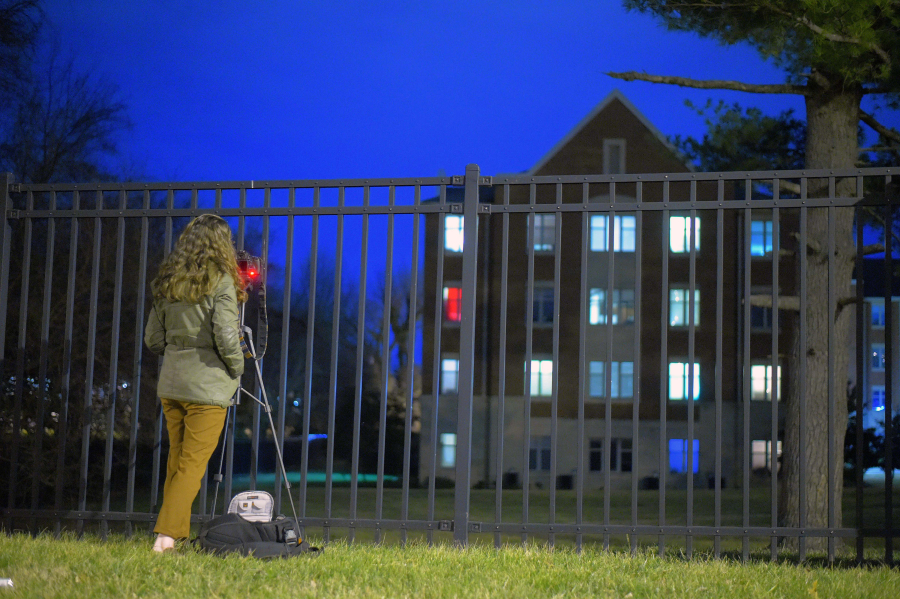BALTIMORE — Once you realize what you’re looking at in Amy Berbert’s seemingly commonplace photograph of a car parked at night in front of a white frame house, it’s the footsteps in the snow that provide an emotional jolt.
Are those blurry indentations moving toward or away from the front door with the welcoming porch light? It’s hard to tell. And who left them? Was the person in a hurry, and if so, why?
“The footsteps,” says Lynn Cazabon, an associate professor of visual arts at the University of Maryland, Baltimore County, “testify to the presence of a person who is no longer there.”
Indeed.
The house is in the 5900 block of Winthrope Ave., where at 7:34 p.m. Jan. 7, 2016, 24-year-old Brian Tabb was pulled from a white convertible. He had been fatally shot.
Berbert is Cazabon’s student, and the 22-year-old college senior snapped that photo at 7:34 p.m. Jan. 7, 2017 — precisely one year to the minute after police were notified of Tabb’s shooting.
It’s part of a series of photographs that Berbert is creating for the Instagram presentation Stains on the Sidewalk that will memorialize the 318 people who were victims of homicides in 2016 in the city of Baltimore. Berbert posts each image the same day she takes it. Her synopsis: “An Exploration of Homicide in Baltimore City. Same Day. Same Time. Same Place. One Year Later.”
It’s also similar to other projects that attempt to use art to drive home the toll exacted by murders, from Single Carrot Theatre, which for years did a staged reading of the “Murder Ink” column started by Baltimore City Paper’s Anna Ditkoff, to the toe tags bearing the names of the victims of gun violence that were attached to a chain-link fence in an exhibit last year at the Reginald F. Lewis Museum of Maryland African American History & Culture.
To find locations, Berbert mines online databases of homicides kept by The Baltimore Sun and City Paper. The images she takes with her camera, a Canon 5D Mark III, “aren’t gruesome and are respectful of the people involved,” she said. “They don’t judge anyone. It’s just a moment of silence to remember these people, and the fact that they lived and died in that place.”
During the first month of 2017, Berbert posted 15 photos, including one commemorating 53-year-old Eugene Gordon Jr., who was shot Jan. 16, 1992, but didn’t succumb to his injuries until 14 years later.
“January of 2016 had only 15 homicides,” Berbert says, and then pauses to reflect on the strangeness of what’s she just said.
” ‘Only.’ That’s kind of a weird thing to say. But, there were almost 40 homicides in Baltimore in July.”
She came up with the idea for the project last year after mulling over a grim statistic: 2015 recorded the highest number of homicides per capita in Baltimore’s history, 344. And 2016 had the second-highest number of per capita homicides, with 2017 off to a worrisome start at 32 homicides in January alone.
For a class project her junior year, Berbert created cinemagraphs, or still photos containing an element that moves, of a few of the places where people had been fatally shot, stabbed or burned in 2015.
Her teacher and other students found the images that resulted compelling and disturbing. But it was the response that Berbert received after exhibiting two of the cinemagraphs in a Rockville gallery over the summer that convinced her that she needed to revisit and expand on her original project.
“The gallery was located in a nice neighborhood with a lot of wealthy people,” Berbert says. “Their visitors were shocked by the cinemagraphs. They said they’d never realized what the situation was or seen it presented in such a personal way.”
Berbert spent last fall working with Cazabon planning the project that would become her senior thesis. The cinemagraph angle was reluctantly dropped; it was too difficult to pull off at night, when it’s dark and when most homicides occur.
And though the project will only be half finished by the time Berbert graduates in May, she is committed to seeing it through.
“I’m planning my whole life this year around other people’s deaths,” she says.
“I can’t go to my cousin’s wedding and I can’t go to Cancun with my boyfriend over spring break because I have to be here for these people.”
The project also means it’s not unusual for the petite Berbert to venture alone and late at night into areas with high crime rates. She says that she keeps her wits about her, texts her parents when she leaves for each shoot and when she returns, and so far hasn’t encountered any unpleasantness.
Cazabon says it’s unusual for students to demonstrate the level of commitment shown by Berbert.
“Amy is an artist,” Cazabon says.



